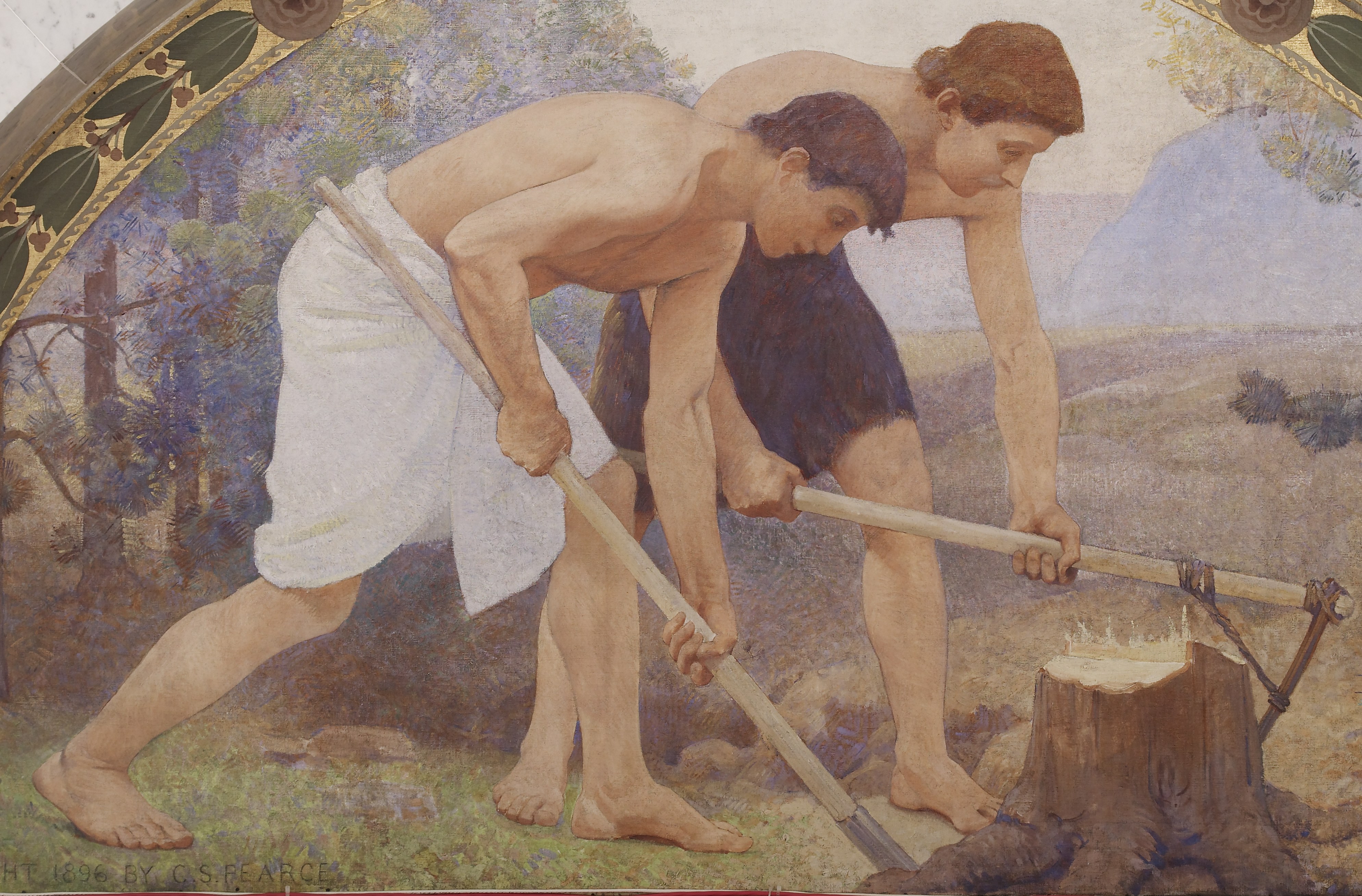The horribleness of the Game
 •
by
•
by Silas Soule
Live Sharp
 Look Smart
Look SmartClick here. Play music now.
Shostakovich's Symphony No. 9 was nominated for the Stalin Prize in 1946, but failed to win it. By order of Glavrertkom, the central censorship board, the work was banned on 14 February 1948. Izrail Nestyev had criticized the symphony in 1946 calling it "..a temporary rejection of great, serious problems for the sake of playful, filigree-trimmed trifles." Shostakovich himself, on the other hand, considered it "a joyful little piece".
My dear friends and acquaintances,
The previous edition of this rather ridiculous journal provided a summary of my latest philosophical explorations into the e-poetics of revolt.
I also promised to provide a summary of my creative writing project, which I like to think of as a "collective e-movie" called The Hatch.
So here, without any further ado, is what this project is all about and a review the story so far.
Critical References
On Day 1839, this esteemed and scholarly journal published its first actual "What if?..." e-Republikan movie storyline in an article called "Tender Lynch: AFA vs. Entrenched Elites".
It was a sketchy attempt at reading eRep events as if they were a movie. Self-described as "a thrilling and a ponderously nasty gem of a movie, with no actual redeeming qualities", that article set the tone for what later emerged as The Hatch project. The storyline presented was a dark and violent reading of e-events, with no aspirational value.

The critical underpinnings of the need to draw sharp attention to the realms of fantasy and fiction within eRepublik were foreshadowed in earlier theoretical explorations published in this journal, most notably the following ones...
Angels of the Revolution, published on Day 1794.
"Angels" dealt with the nature of Glorious Uprisings in general. It dwelt very critically and at some length on the semblances of the institutionalization of revolt that are commonly referred to as revolutionary ideology.
Then it hinted very briefly at the possibility for works that are the watchmen of an irreducible fidelity to that other "angelic" thing of which many have caught a glimpse, that is, of works that tell a story not simply of yet another misstep into the sand before the rising tide of bourgeois rewards, but of an unprecedented experience that can result in actually legislating philosophy to the Masters and not -- as usually happens -- the other way around.
But then it reverted again to hyper-critical mode, again at some length, warning that "..revolution is not about renouncing; it is an affirmative scission (a break, a separation, a revealing, an uncovering, a discovery)".
It stated that a revolutionary attitude is decidedly not "..a sort of aristocratic conviction that revolutionary militancy is first an absolute mental break, followed by spitting on oneself and performing an internal purge." The article even went to the extreme of positing that an attempt at "remaking of oneself is fascist in its sectarian ambition of absolute purity, of absolute simplicity, of starting anew from scratch."
Driving the point home, it even went on to criticize "working hard" as a form of "disappearing" that is completely opposed to the antagonistic type of attitude that is absolutely necessary "for an e-revolutionary class to exist and construct itself".
While this may sound like a political statement (and it is), if you think about it, the real message of that article was fundamentally psychological and even aesthetic.

The satirical WHBR 1760.2 - ¡Evolución y la dialéctica!, published on Day 1760.
It should perhaps be noted that that edition was not written in Spanish -- only the title is in Spanish. The title -- and the picture of Muriel Castro -- were intended to emphasize in a humorous and ironic way that the revolution's children will always find a way to expose the failures and shortcomings of the revolution's fathers.
This amusing satire of "WHPR" evoked and played with the kind of "let's find the story within a story" play-acting that led to the development of The Hatch experiment.
The edition started out with a tongue-in-cheek literary-like examination of "The Tragedy of the Pizza". It examined the guilty pleasures involved in watching Pizza slide off the plate and onto the floor -- again and again and again.
It matter-of-factly stated that "we can logically conclude that -- utterly contrary to standard pizzaian views -- nobody would have been lost had pizza never come to save the e-Earth; and every player had to fall so that pizza could be delivered to some of them."
Next the Day 1760 satire edition examined the effect of the subjectivity of perception on recollection (the so-called Rashoman effect) by examining various perceptions of Civil Anarchy (which are all true), as well as the lyrics of the old Wobbly anthem "Ballad of Joe Hill". It then drew attention to the phenomenon of subjective reversal: forgetting to include oneself, one's own subjective position, within a series of perceptions.
Finally, the light-hearted exploration of e-evolution and e-dialectics concluded by noting, in an almost off-handed manner, that an ironic displacement of the symbolic order is (obviously) achieved via collective transubstantiation.
In other words: we recover our e-humanity by gathering together to honor the holy spirit that resides in each of us.
All a bit esoteric, to be sure, but worth pondering and although seemingly "spiritual", more in a historical and social-organizing sense than in a religious one.

Most especially and fundamentally, we find the origins of this fascination with e-movie-making in a piece guest-written by Delmar Abdulmeningitis on Day 1744 titled Tractacus e-Logico-Philosophicus, which, among other things, presented a second-hand outline for an "eRepublikan novel".
The article began with a subtle warning that "the game is afoot", since any sensible reader, especially any regualr readers of PQ's rants, would have reasonably doubted as to whether there really was any such e-character as "Delmar Abdulmeningitis".
More important for our purposes today, it can be noted that the "Tractacus" flatly states that: "Quinn has argued -- occasionally at great length -- the Game can only be represented by the arts. It is not the aestheticization of the Game which is false, but its reduction to being the object of documentary reports. Every attempt to 'reproduce the facts' in a documentary way neutralizes the traumatic impact of e-events -- or as other popular secular spiritualist blues fans have put it: truth has the structure of fiction."
And just in case anybody missed the point, it is repeated, even more emphatically:
"The horribleness of the Game cannot be represented; but this excess of represented content over its aesthetic representation has to infect the aesthetic form itself. What cannot be described should be inscribed into the artistic form as its uncanny distortion.
..
Returning to the topic of game-induced trauma: we cannot directly talk about or describe it, but the traumatic excess can nevertheless be 'shown' in the distortion of our speech about the trauma, in its elliptic repetitions and other distortions."

Hanging by a Thread
The project for The Hatch itself was launched by way of two introductory theoretical pieces that were published on Days 1915 and 1916.
They attempted to answer the question alluded to at the conlusion of the "Tractacus":
Can we capture the Real that emerges in the guise of an illusory spectacle, or is this all just a hopeless attempt to avoid the real of the illusion itself?
These two pieces were entitle
😛
What To Do in Times Like This
and
What To Do in Times Like This - Part Two
A great deal is written in those two articles about themes that could and should be explored in a collective project like The Hatch. Potential participants in this experiment should re-read those pieces.
The project is clearly revolutionary and antagonistic in nature. It is not simply a "story-writing contest". It actively seeks to drive a sharp wedge between two camps of players: "...one stands for an honest if brutal confrontation with the raw horror of boredom, pixel-addiction and the spectacularized e-consumption of dead time, while in the other, reality is carefully screened".
The Hatch demands a bleak and fatalistic worldview, a Greek tragedy, a Russian film-noir, a shouting blues...
"We pretend to war against elitism and cheating, but in truth, the e-system simply brutalizes and dehumanizes the underclass of players who are no longer needed as a labor supply. The Hatch will not be a film about eRepublik per se; it will be about the eRepublikans that got left behind."
The "What To Do In Times Like These" articles challenge e-screen-writers to depict of the most utopian of e-dreams, including an examination of the nature of real friendship and betrayal, and of "the problem of the true ethical act: what can a (relatively) honest player do in today's conditions?"

A number of suggestions are made for depicting ensembles within the storylines. The "guidebook" articles strongly recommend against creating romantic heroes and romantic rebels. They encourage instead a focus on disrepectful anti-heroes and unexpected co-conspirators: "...a group of eccentrics from a Charles Dickens novel.., with some smelly and dilapidated basement office as their secret conspiratorial lair."
In the end, The Hatch is conceived as a murder mystery in which the culprit is the e-social totality and the victim is our lost, forgotten and disappointed players.
If it becomes "a comedy that is darker than tragedy, then we will have accomplished something."

The Story So Far
So far, only four episodes of The Hatch have been presented, all of them under the story-line of "My Favorite Game" and all of them introducing various characters...
Episode One: My Favorite Game
Marcina Sandormaria is introduced. We learn a bit about her dysfunctioal family and one of her lovers, who is a heavily tatooed man named Dragon.

Episode Two: My Favorite Game, part two
We meet Petofi, who is Sandormaria's best friend and confidante. Through their dialogue, we begin to sense the problems with the e-world.

Episode Three: My Favorite Game, part three
In this episode, we discover that Sandormaria, despite having a successful literary career and being respected by various cliques, finds something lacking in her e-life and so tries engaging in labor.

and
Episode Four: My Favorite Game, part four
We meet Armoral and his wife, Batgirl Glee Sims, who, like Sandormaria, is a writer. Although their love life seems at first to be intense and interesting, we discover that they are bored.

The Challenge
In Improv theater, a well-known technique is "Yes, And..."
That is your challenge here. Pick up on any phrase, thread, named or implied character in the four episodes shown so far and make a suggestion for where to take it next. If you are especially motivated, feel free to write an episode and link to it.
Wonderful prizes will be awarded according to my own capricious and no doubt unworthy and biased evaluations as to:
* How closely you stuck to the improvisation vs. veering wildly off into some new story-line.
* If you do veer off into a new story-line, how awesome it is.
* Whether or not you stick to the "terminally bleak, but funny/amusing/comical" characterizations.
* Spelling.

Roll away the dew...


Comments
Have fun. Be awesome.
It seems pretty ironic, " Writing an article as a response to (The horribleness of the game) "
I'll give it a shot.
I like your use of white space in your work
Nice to have Shostakovich as background music.
But you realize you will only reach about 3 people with this article? Not because of Shostakovich, but because of the density of your writing style.
But the pics were good.
As long as it was the 3 best people, I'm fine with that.
Quality over quantity.